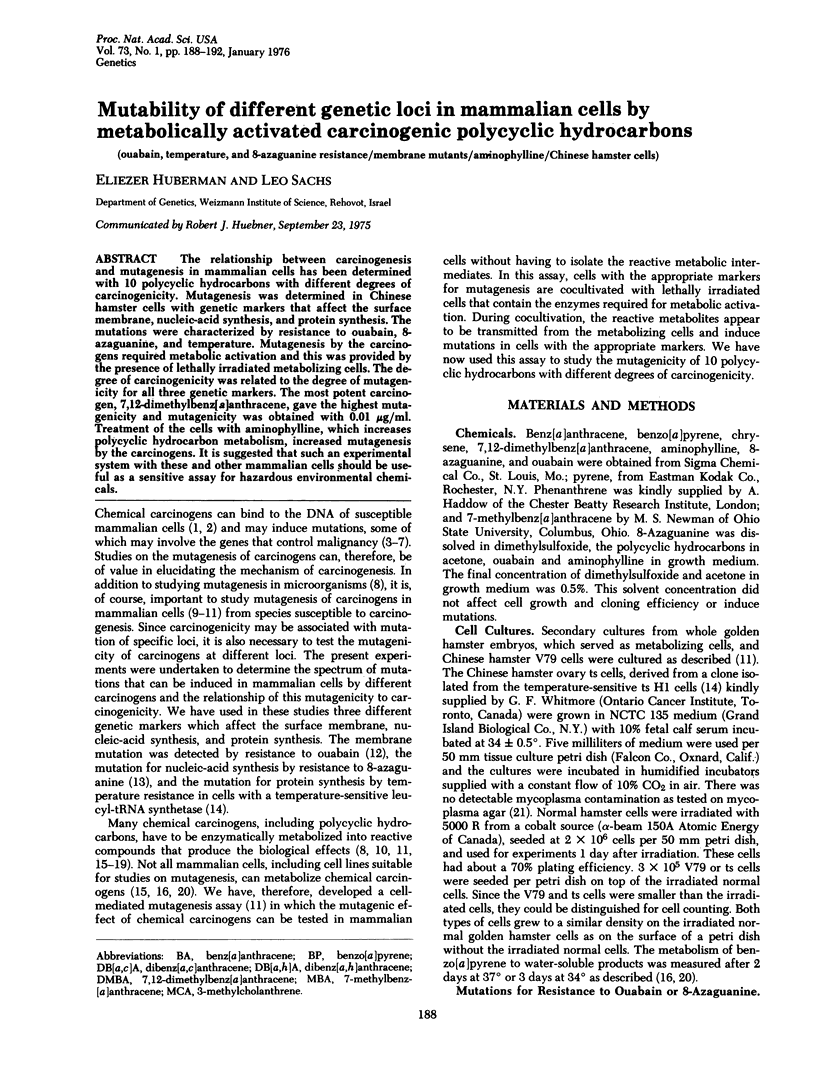Abstract
The relationship between carcinogenesis and mutagenesis in mammalian cells has been determined with 10 polycyclic hydrocarbons with different degrees of carcinogenicity. Mutagenesis was determined in Chinese hamster cells with genetic markers that affect the surface membrane, nucleic-acid synthesis, and protein synthesis. The mutations were characterized by resistance to ouabain, 8-azaguanine, and temperature. Mutagenesis by the carcinogens required metabolic activation and this was provided by the presence of lethally irradiated metabolizing cells. The degree of carcinogenicity was related to the degree of mutagenicity for all three genetic markers. The most potent carcinogen, 7,12-dimethylbenz[a]anthracene, gave the highest mutagenicity and mutagenicity was obtained with 0.01 mug/ml. Treatment of the cells with aminophylline, which increases polycyclic hydrocarbon metabolism, increased mutagenesis by the carcinogens. It is suggested that such an experimental system with these and other mammalian cells should be useful as a sensitive assay for hazardous environmental chemicals.
Full text
PDF




Selected References
These references are in PubMed. This may not be the complete list of references from this article.
- Ames B. N., Durston W. E., Yamasaki E., Lee F. D. Carcinogens are mutagens: a simple test system combining liver homogenates for activation and bacteria for detection. Proc Natl Acad Sci U S A. 1973 Aug;70(8):2281–2285. doi: 10.1073/pnas.70.8.2281. [DOI] [PMC free article] [PubMed] [Google Scholar]
- CHANOCK R. M., HAYFLICK L., BARILE M. F. Growth on artificial medium of an agent associated with atypical pneumonia and its identification as a PPLO. Proc Natl Acad Sci U S A. 1962 Jan 15;48:41–49. doi: 10.1073/pnas.48.1.41. [DOI] [PMC free article] [PubMed] [Google Scholar]
- Chu E. H., Malling H. V. Mammalian cell genetics. II. Chemical induction of specific locus mutations in Chinese hamster cells in vitro. Proc Natl Acad Sci U S A. 1968 Dec;61(4):1306–1312. doi: 10.1073/pnas.61.4.1306. [DOI] [PMC free article] [PubMed] [Google Scholar]
- Gelboin H. V., Huberman E., Sachs L. Enzymatic hydroxylation of benzopyrene and its relationship to cytotoxicity. Proc Natl Acad Sci U S A. 1969 Dec;64(4):1188–1194. doi: 10.1073/pnas.64.4.1188. [DOI] [PMC free article] [PubMed] [Google Scholar]
- Heidelberger C. Chemical oncogenesis in culture. Adv Cancer Res. 1973;18:317–366. doi: 10.1016/s0065-230x(08)60756-3. [DOI] [PubMed] [Google Scholar]
- Huberman E., Aspiras L., Heidelberger C., Grover P. L., Sims P. Mutagenicity to mammalian cells of epoxides and other derivatives of polycyclic hydrocarbons. Proc Natl Acad Sci U S A. 1971 Dec;68(12):3195–3199. doi: 10.1073/pnas.68.12.3195. [DOI] [PMC free article] [PubMed] [Google Scholar]
- Huberman E., Fogel M. Activation of carcinogenic polycyclic hydrocarbons in polyoma-virus-transformed cells as a prerequisite for polyoma virus induction. Int J Cancer. 1975 Jan 15;15(1):91–98. doi: 10.1002/ijc.2910150111. [DOI] [PubMed] [Google Scholar]
- Huberman E., Sachs L. Cell-mediated mutagenesis of mammalian cells with chemical carcinogens. Int J Cancer. 1974 Mar 15;13(3):326–333. doi: 10.1002/ijc.2910130308. [DOI] [PubMed] [Google Scholar]
- Huberman E., Sachs L. Metabolism of the carcinogenic hydrocarbon benzo(a)pyrene in human fibroblast and epithelial cells. Int J Cancer. 1973 Mar 15;11(2):412–418. doi: 10.1002/ijc.2910110218. [DOI] [PubMed] [Google Scholar]
- Huberman E., Selkirk J. K., Heidelberger C. Metabolism of polycyclic aromatic hydrocarbons in cell cultuires. Cancer Res. 1971 Dec;31(12):2161–2167. [PubMed] [Google Scholar]
- Huberman E., Yamasaki H., Sachs L. Genetic control of the regulation of cell susceptibility to carcinogenic polycyclic hydrocarbons by cyclic AMP. Int J Cancer. 1974 Dec 15;14(6):789–798. doi: 10.1002/ijc.2910140613. [DOI] [PubMed] [Google Scholar]
- Huebner R. J., Todaro G. J. Oncogenes of RNA tumor viruses as determinants of cancer. Proc Natl Acad Sci U S A. 1969 Nov;64(3):1087–1094. doi: 10.1073/pnas.64.3.1087. [DOI] [PMC free article] [PubMed] [Google Scholar]
- Kao F. T., Puck T. T. Genetics of somatic mammalian cells. XII. Mutagenesis by carcinogenic nitroso compounds. J Cell Physiol. 1971 Aug;78(1):139–144. doi: 10.1002/jcp.1040780117. [DOI] [PubMed] [Google Scholar]
- Kouri R. E., Kiefer R., Zimmerman E. M. Hydrocarbon-metabolizing activity of various mammalian cells in culture. In Vitro. 1974 Jul-Aug;10:18–25. doi: 10.1007/BF02615334. [DOI] [PubMed] [Google Scholar]
- Kuroki T., Heidelberger C. The binding of polycyclic aromatic hydrocarbons to the DNA, RNA, and proteins of transformable cells in culture. Cancer Res. 1971 Dec;31(12):2168–2176. [PubMed] [Google Scholar]
- Miller E. C., Miller J. A. Mechanisms of chemical carcinogenesis: nature of proximate carcinogens and interactions with macromolecules. Pharmacol Rev. 1966 Mar;18(1):805–838. [PubMed] [Google Scholar]
- Temin H. M. On the origin of the genes for neoplasia: G.H.A. Clowes memorial lecture. Cancer Res. 1974 Nov;34(11):2835–2841. [PubMed] [Google Scholar]
- Thompson L. H., Harkins J. L., Stanners C. P. A mammalian cell mutant with a temperature-sensitive leucyl-transfer RNA synthetase. Proc Natl Acad Sci U S A. 1973 Nov;70(11):3094–3098. doi: 10.1073/pnas.70.11.3094. [DOI] [PMC free article] [PubMed] [Google Scholar]
- Todaro G. J., Huebner R. J. N.A.S. symposium: new evidence as the basis for increased efforts in cancer research. Proc Natl Acad Sci U S A. 1972 Apr;69(4):1009–1015. doi: 10.1073/pnas.69.4.1009. [DOI] [PMC free article] [PubMed] [Google Scholar]
- Yamamoto T., Rabinowitz Z., Sachs L. Identification of the chromosomes that control malignancy. Nat New Biol. 1973 Jun 20;243(129):247–250. doi: 10.1038/newbio243247a0. [DOI] [PubMed] [Google Scholar]
- Yamasaki H., Huberman E., Sachs L. Regulation of aryl hydrocarbon (benzo-(A)-pyrene) hydroxylase activity in mammalian cells. Induction of hydroxylase activity by N6,O2'-dibutyryl8 adenosine 3':5'-monophosphate and aminophylline. J Biol Chem. 1975 Oct 10;250(19):7766–7770. [PubMed] [Google Scholar]


